Development and Characterization of Innovative Hemp–Gypsum Composites for Application in the Building Industry
Abstract
1. Introduction
2. Materials and Methods
2.1. Materials
2.2. Sample Preparation
2.3. Experimental Program
- Surface hardness: Measured using a Shore C durometer. It reflects the resistance of gypsum composites to surface scratching. The test is conducted according to the UNE 102042:2023 standard [46], using five measurements on two plane-parallel faces separated by at least 2 cm from each other and from the ends.
- Dynamic elastic modulus: Employing a C368 ultrasonic emission-reception device by Matest (Treviolo, Italy), with 55 kHz contact transceiver probes measuring longitudinally along the 16 cm dimension of the specimen.
- Flexural strength: Utilizing a hydraulic press by Ibertest, model AUTOTEST 200–10SW (Madrid, Spain). It consists in a simple three-point bending test conducted in accordance with the EN 13279-2:2014 standard [44]. A loading speed of 10 N/s was applied, testing the samples until fracture.
- Compressive strength: In accordance with the EN 13279-2:2014 standard [44] and using the aforementioned equipment. The test is performed on the half specimens obtained after the flexural test, with a loading speed of 20 N/s until the final fracture of the gypsum composites.
- SEM analysis: Conducted on a sample extracted from the matrix of the cured gypsum composite and previously coated with a thin gold film using a Cressington 108 auto metallizer (Watford, UK). The analysis is performed using a TESCAN Vega 4 scanning electron microscope (Watford, UK), with color cathodoluminescence and two EDX Bruker detectors (30 and 60 mm2) operating at 20 kV.
- Capillary water absorption: Determined according to the EN 1925:1999 standard. It relates the mass of water absorbed by the gypsum composites per unit area and as a function of time [47].
- Maximum height reached by water in the capillarity test: Determined as the average of three values measured on each specimen, reflecting the final height reached by the water after 40 min of capillarity test. Infrared images were also taken to understand the water evolution inside the composites.
- Total water absorption: Performed adapting the indications in the EN 14617-1:2013 standard [48]. In order to do this, the samples were completely submerged in water for a period of 8 h, after which the percentage change in mass experienced by the gypsum composites due to water absorption was obtained.
- Open porosity: Defined as the ratio between the volume of accessible pores and the apparent volume of the material. It was determined using the method outlined in the EN 1936:2007 standard [49].
- Bulk density: Defined as the ratio between the dry state mass and the bulk volume of the different analyzed samples and determined following the indications included in the EN 13279-2 standard [44].
- Thermal conductivity: Using samples of size 24 × 24 × 2 cm3, the thermal conductivity coefficient of the composites was determined with the help of a mini Hot-Box equipped with thermocouples.
- Flexural strength in panels: The maximum breaking load was determined on prefabricated panels measuring 40 × 30 × 1.5 cm3. For this purpose, two types of prefabricated panels were designed, with and without Kraft paper reinforcement. Tests were conducted according to the EN 12859:2012 standard [50].
- Impact hardness: It represents the ability of the samples to absorb energy during the impact. The test is carried out following the indications included in the EN 12859:2012 standard [50], using a 50 mm-diameter steel ball that impacts the panel when falling freely from a height of 50 cm.
3. Results
3.1. Mechanical Characterization
3.2. Tests on Behavior Regarding Water Exposure
3.3. Tests on Prefabricated Elements
3.4. Critical Discussion and Potential Applications
4. Conclusions
- The partial replacement of gypsum with hemp in powder and fiber has been observed to decrease the surface hardness of the cured composites while reducing the compressive strength with respect to traditional gypsum material. Nevertheless, even with a decrease in strength of around 40% with a 30% substitution of gypsum with hemp in the most unfavorable case, the obtained strength still exceeded the minimum value set by regulations by more than 3 MPa.
- The G0.65–15%F compound exhibited the best results in flexural strength tests, achieving higher strength values than the reference material G0.65. Notably, in the study with prefabricated elements, all panels made with Kraft paper reinforcement exceeded the minimum value set by regulations at 0.18 kN.
- The composites with hemp incorporation showed a good performance against water action, reducing the water absorption through capillarity and the final height reached by the liquid inside the composite.
- All samples that used hemp as a partial substitution for gypsum obtained lower values of bulk density and thermal conductivity than the original composite G0.65, achieving a reduction in thermal conductivity close to 50% in some cases. Furthermore, SEM images demonstrated the effective integration of hemp material into the gypsum matrix, resulting in a homogeneous and cohesive distribution.
Author Contributions
Funding
Institutional Review Board Statement
Informed Consent Statement
Data Availability Statement
Acknowledgments
Conflicts of Interest
References
- Bel-Anzué, P.; Elert, K. Changes in traditional building materials: The case of gypsum in Northern Spain. Archaeol. Anthropol. Sci. 2021, 13, 177. [Google Scholar] [CrossRef]
- Pedreño-Rojas, M.A.; Fořt, J.; Černý, R.; Rubio-de-Hita, P. Life cycle assessment of natural and recycled gypsum production in the Spanish context. J. Clean. Prod. 2020, 253, 120056. [Google Scholar] [CrossRef]
- Doleželová, M.; Scheinherrová, M.; Krejsová, J.; Keppert, M.; Černý, R.; Vimmrová, A. Investigation of gypsum composites with different lightweight fillers. Constr. Build. Mater. 2021, 297, 123791. [Google Scholar] [CrossRef]
- Pedreño-Rojas, M.A.; Flores-Colen, I.; de Brito, J.; Rodríguez-Liñán, C. Influence of the heating process on the use of gypsum wastes in plasters: Mechanical, thermal and environmental analysis. J. Clean. Prod. 2019, 215, 444–457. [Google Scholar] [CrossRef]
- Vidales-Barriguete, A.; Santa-Cruz-Astorqui, J.; Piña-Ramírez, C.; Kosior-Kazberuk, M.; Kalinowska-Wichrowska, K.; Atanes-Sánchez, E. Study of the Mechanical and Physical Behavior of Gypsum Boards with Plastic Cable Waste Aggregates and Their Application to Construction Panels. Materials 2021, 14, 2255. [Google Scholar] [CrossRef]
- Balti, S.; Boudenne, A.; Dammark, L.; Hamdi, N. Mechanical and thermophysical characterization of gypsum composites reinforced by different wastes for green building applications. Constr. Build. Mater. 2023, 372, 130840. [Google Scholar] [CrossRef]
- Guijarro-Miragaya, P.; Ferrández, D.; Atanes-Sánchez, E.; Zaragoza-Benzal, A. Characterization of a New Lightweight Plaster Material with Superabsorbent Polymers and Perlite for Building Applications. Buildings 2023, 13, 1641. [Google Scholar] [CrossRef]
- del Río, M.; Vidales, A.; Piña, C.; Vitiello, V.; Santa Cruz-Astorqui, J.; Castelluccio, R. A review of the research about gypsum mortars with waste aggregates. J. Build. Eng. 2022, 45, 103338. [Google Scholar] [CrossRef]
- Li, Z.; Wang, X.; Yan, W.; Ding, L.; Liu, J.; Wu, Z.; Huang, H. Physical and mechanical properties of gypsum-based composites reinforced with basalt, glass, and PVA fibers. J. Build. Eng. 2023, 64, 105640. [Google Scholar] [CrossRef]
- Elaiwi, E.H.; Ibrahim, A.K.; Al-Chalabi, S.F.; Abbood, A.A.; Hussein, F.M.; Hussein, H.H.; Al-Ridha, A.S.D. The influence of water-gypsum ratio on the properties of national gypsum (Jοss) for various additives. Mater. Today Proc. 2023, 80, 1327–1333. [Google Scholar] [CrossRef]
- Ferrández, D.; Álvarez Dorado, M.; Zaragoza-Benzal, A.; Leal Matilla, A. Feasibility of Ecofriendly Mortars with Different Hemp Additions for Use in Building Sector. Heritage 2023, 6, 4901–4918. [Google Scholar] [CrossRef]
- Bollino, F.; Giannella, V.; Armentani, E.; Sepe, R. Mechanical behavior of chemically-treated hemp fibers reinforced composites subjected to moisture absorption. J. Mater. Res. Technol. 2023, 22, 762–775. [Google Scholar] [CrossRef]
- Ferreira, S.R.; Pepe, M.; Matrinelli, E.; Andrade Silva, F.; Toledo Filho, R.D. Influence of natural fibers characteristics on the interface mechanics with cement based matrices. Compos. Part B Eng. 2018, 140, 183–196. [Google Scholar] [CrossRef]
- Keener, T.J.; Stuart, R.K.; Brown, T.K. Maleated coupling agents for natural fibre composites. Compos. Part A Appl. Sci. Manuf. 2004, 35, 357–362. [Google Scholar] [CrossRef]
- Stocchi, A.; Lauke, B.; Vázquez, A.; Bernal, C. A novel fiber treatment applied to woven jute fabric/vinylester laminates. Compos. Part A Appl. Sci. Manuf. 2007, 38, 1337–1343. [Google Scholar] [CrossRef]
- Iucolano, F.; Caputo, D.; Leboffe, F.; Liguori, B. Mechanical behavior of plaster reinforced with abaca fibers. Constr. Build. Mater. 2015, 99, 184–191. [Google Scholar] [CrossRef]
- Correa Gomes, D.A.; de Novais Miranda, E.H.; Resende, F.C.; Vega Villaruel, D.C.; Marin Mendes, L.; Guimaraes Júnior, J.B. Analysis of the influence of wheat residues on gypsum composites. Innov. Infrastruct. Soluntions 2023, 8, 31. [Google Scholar] [CrossRef]
- Miraoui, I.; Jaballi, S.; Rabeh, S. Analysis of long unidirectional sisal fibers reinforced plaster: An experimental investigation. Mater. Today Proc. 2022, 52, 152–157. [Google Scholar] [CrossRef]
- Medjmadj, S.; Si Salem, A.; Ait Taleb, S. Experimental behavior of plaster/cork functionally graded core sandwich panels with polymer skins. Constr. Build. Mater. 2022, 344, 128257. [Google Scholar] [CrossRef]
- Svetlana, P.; Toussaint, B.; Paul-Antoine, S.; Yann, Q. Valorization of virgin cork by the design of cork-plaster composites. Inorg. Chem. Commun. 2024, 161, 111782. [Google Scholar] [CrossRef]
- Mehrez, I.; Hachem, H.; Jemni, A. Thermal insulation potential of wood-cereal straws/plaster composite. Case Stud. Constr. Mater. 2022, 17, e01353. [Google Scholar] [CrossRef]
- Touil, M.; Lachheb, A.; Saadani, R.; Rachid Kabiri, M.; Rahmoune, M. A new experimental strategy assessing the optimal thermo-mechanical properties of plaster composites containing Alfa fibers. Energy Build. 2022, 262, 111984. [Google Scholar] [CrossRef]
- Segura Alcaraz, J.; Montava, I.; Juliá Sanchis, E.; Gadea Borrel, J.M. Mechanical properties of plaster reinforced with yute fabrics. Compos. Part B Eng. 2019, 178, 107390. [Google Scholar] [CrossRef]
- Aramwit, P.; Vui Sheng, D.D.C.; Krishna Moorthy, G.; Guna, V.; Reddy, N. Rice husk and coir fibers as sustainable and green reinforcements for high performance gypsum composites. Constr. Build. Mater. 2023, 393, 132065. [Google Scholar] [CrossRef]
- Braiek, A.; Karkri, M.; Adili, A.; Ibos, L.; Nasrallah, S.B. Estimation of the thermophysical properties of date palm fibers/gypsum composite for use as insulating materials in building. Energy Build. 2017, 140, 268–279. [Google Scholar] [CrossRef]
- Jia, R.; Wang, Q.; Feng, P. A comprehensive overview of fibre-reinforced gypsum-based composites (FRGCs) in the construction field. Compos. Part B Eng. 2021, 205, 108540. [Google Scholar] [CrossRef]
- Rashid, B.; Leman, Z.; Jawaid, M.; Ishak, M.R.; Al-Oqla, F.M. Eco-Friendly Composites for Brake Pads from Agro Waste: A Review. Encycl. Mater. Compos. 2017, 3, 209–228. [Google Scholar] [CrossRef]
- Hussain, A.; Calabria-Holley, J.; Lawrence, M.; Ansell, M.P.; Jiang, Y.; Schorr, D.; Blanchet, P. Development of novel building composites based on hemp and multi-functional silica matrix. Compos. Part B Eng. 2019, 156, 266–273. [Google Scholar] [CrossRef]
- Prade, T.; Svensson, S.E.; Andersson, A.; Mattsson, J.E. Biomass and energy yield of industrial hemp grown for biogas and solid fuel. Biomass Bioenergy 2011, 35, 3040–3049. [Google Scholar] [CrossRef]
- Shea, A.; Lawrence, M.; Walker, P. Hygrothermal performance of an experimental hemp–lime building. Constr. Build. Mater. 2012, 36, 270–275. [Google Scholar] [CrossRef]
- Çomak, B.; Bideci, A.; Salli bideci, Ö. Effects of hemp fibers on characteristics of cement based mortar. Constr. Build. Mater. 2018, 169, 794–799. [Google Scholar] [CrossRef]
- Jami, T.; Karade, S.R.; Singh, L.P. A review of the properties of hemp concrete for green building applications. J. Clean. Prod. 2019, 239, 117852. [Google Scholar] [CrossRef]
- Boccarusso, L.; Durante, M.; Iucolano, F.; Mocerino, D.; Langella, A. Production of hemp-gypsum composites with enhanced flexural and impact resistance. Constr. Build. Mater. 2020, 260, 120476. [Google Scholar] [CrossRef]
- Babu, K.S.; Ratnam, C. Mechanical and thermophysical behavior of hemp fiber reinforced gypsum composites. Mater. Today Proc. 2021, 44, 2245–2249. [Google Scholar] [CrossRef]
- Iucolano, F.; Boccarusso, L.; Langella, A. Hemp as eco-friendly substitute of glass fibres for gypsum reinforcement: Impact and flexural behaviour. Compos. Part B Eng. 2019, 175, 107073. [Google Scholar] [CrossRef]
- Iucolano, F.; Liguori, B.; Aprea, P.; Caputo, D. Thermo-mechanical behaviour of hemp fibers-reinforced gypsum plasters. Constr. Build. Mater. 2018, 185, 256–263. [Google Scholar] [CrossRef]
- Shewalul, Y.W.; Flores, N.; Streicher, D.; Walls, R. Fire behavior of hemp blocks: A biomass-based construction material. J. Bulding Eng. 2023, 80, 108147. [Google Scholar] [CrossRef]
- Iucolano, F.; Liguori, B.; Aprea, P.; Caputo, D. Evaluation of bio-degummed hemp fibers as reinforcement in gypsum plaster. Compos. Part B Eng. 2018, 138, 149–156. [Google Scholar] [CrossRef]
- EN 13279-1:2009; Gypsum Binders and Gypsum Plasters—Part 1: Definitions and Requirements. British Standards Institution (BSI): London, UK, 2009.
- Romero-Gómez, M.I.; Costa-Pereira, M.F.; Soares Dias, A.P.; Flores-Colen, I. Influence of high-temperature exposure on the properties of gypsum-plastic waste composites: Thermophysical and microstructural analysis. J. Build. Eng. 2023, 79, 107862. [Google Scholar] [CrossRef]
- Pedreño-Rojas, M.A.; Morales-Conde, M.J.; Pérez-Gálvez, F.; Rubio de Hita, P. Influence of polycarbonate waste on gypsum composites: Mechanical and environmental study. J. Clean. Prod. 2019, 218, 21–37. [Google Scholar] [CrossRef]
- Placo Saint Gobain. Available online: https://www.placo.es/Producto/iberfinor#marketing-description (accessed on 21 January 2024).
- European Union. Council Directive (EU) 98/83/EC of 3 November 1998 on the quality of water intended for human consumption. Off. J. Eur. Communities 1998, 330, 32–54. [Google Scholar]
- EN 13279-2:2014; Gypsum Binders and Gypsum Plasters—Part 2: Test Methods. European Committee for Standardisation: Brussels, Belgium, 2014.
- Lederer, J.; Gassner, A.; Fellner, J.; Mollay, U.; Schremmer, C. Raw materials consumption and demolition waste generation of the urban building sector 2016–2050: A scenario-based material flow analysis of Vienna. J. Clean. Prod. 2021, 288, 125566. [Google Scholar] [CrossRef]
- UNE 102042:2023; Gypsum Plasters. Other Test Methods. AENOR: Madrid, Spain, 2023.
- EN 1925:1999; Natural Stone Test Methods—Determination of Water Absorption Coefficient by Capillarity. European Committee for Standardisation: Brussels, Belgium, 1999.
- EN 14617-1:2013; Agglomerated Stone—Test Methods—Part 1: Determination of Apparent Density and Water Absorption. European Committee for Standardisation: Brussels, Belgium, 2013.
- EN 1936:2007; Natural Stone Test Methods—Determination of Real Density and Apparent Density, and of Total and Open Porosity. European Committee for Standardisation: Brussels, Belgium, 2007.
- EN 12859:2012; Gypsum Blocks—Definitions, Requirements and Test Methods. European Committee for Standardisation: Brussels, Belgium, 2012.
- Leiva-Aguilera, M.J. Escayola aditivada con residuos de cáscara de arroz. Doctoral Thesis, Universidad Politécnica de Madrid, Madrid, Spain, 2017. [Google Scholar] [CrossRef]
- Jimenez Rivero, A.; Guzmán Báez, A.; García Navarro, J. New composite gypsum plaster—Ground waste rubber coming from pipe foam insulation. Constr. Build. Mater. 2014, 55, 145–152. [Google Scholar] [CrossRef]
- Ferrández, D.; Álvarez, M.; Zaragoza-Benzal, A.; Santos, P. Eco-Design and Characterization of Sustainable Lightweight Gypsum Composites for Panel Manufacturing including End-of-Life Tyre Wastes. Materials 2024, 17, 635. [Google Scholar] [CrossRef]
- Hernández-Olivares, F.; Bollati, M.R.; del Río, M.; Parga-Landa, B. Development of cork–gypsum composites for building applications. Constr. Build. Mater. 1999, 13, 179–186. [Google Scholar] [CrossRef]
- Abir, N.; Bakr Siddique, A.; Ara Begum, H.; Abdul, M.; Nabi, A.; Arif Mahmud, M. Effect of fibre loading on mechanical properties of jute fibre bundle reinforced gypsum composites. Heliyon 2023, 9, e18147. [Google Scholar] [CrossRef]
- Romero-Gómez, M.I.; Silva, R.V.; Costa-Pereira, M.F.; Flores-Colen, I. Thermal and mechanical performance of gypsum composites with waste cellulose acetate fibres. Constr. Build. Mater. 2022, 356, 129308. [Google Scholar] [CrossRef]
- Zaragoza-Benzal, A.; Ferrández, D.; Atanes-Sánchez, E.; Morón, C. New lightened plaster material with dissolved recycled expanded polystyrene and end-of-life tyres fibres for building prefabricated industry. Case Stud. Constr. Mater. 2023, 18, e02178. [Google Scholar] [CrossRef]
- Collet, F.; Bart, M.; Serres, L.; Miriel, J. Porous structure and water vapour sorption of hemp-based materials. Constr. Build. Mater. 2008, 22, 1271–1280. [Google Scholar] [CrossRef]
- Castillo Rodríguez, A.P.; García Navarro, J. Gypsum compounds with the addition of post-consumer textile fibres of cotton. Inf. Construcción 2023, 75, 571. [Google Scholar] [CrossRef]
- Vidales-Barriguete, A.; Atanes-Sánchez, E.; Rio-Merino, M.; Piña-Ramírez, C. Analysis of the improved water-resistant properties of plaster compounds with the addition of plastic waste. Constr. Build. Mater. 2020, 230, 116956. [Google Scholar] [CrossRef]
- Poletanovic, B.; Janotka, I.; Janek, M.; Bacuvcik, M.; Merta, I. Influence of the NaOH-treated hemp fibres on the properties of fly-ash based alkali-activated mortars prior and after wet/dry cycles. Constr. Build. Mater. 2021, 309, 125072. [Google Scholar] [CrossRef]
- Guna, V.; Yadav, C.; Maithri, B.R.; Ilangovan, M.; Touchaleaume, F.; Saulnier, B.; Grohens, Y.; Reddy, N. Wool and coir fiber reinforced gypsum ceiling tiles with enhanced stability and acoustic and thermal resistance. J. Build. Eng. 2021, 41, 102433. [Google Scholar] [CrossRef]
- Sair, S.; Mandili, B.; Taqi, M.; El Bouari, A. Development of a new eco-friendly composite material based on gypsum reinforced with a mixture of cork fibre and cardboard waste for building thermal insulation. Compos. Comun. 2019, 16, 20–24. [Google Scholar] [CrossRef]
- Álvarez, M.; Santos, P.; Lopes, P.; Abrantes, D.; Ferrández, D. Performance Characterisation of a New Plaster Composite Lightened with End-of-Life Tyres’ Recycled Materials for False Ceiling Plates. Materials 2022, 15, 5660. [Google Scholar] [CrossRef]
- Santos, P.; Lopes, P.; Abrantes, D. Thermal Performance of Load-Bearing, Lightweight, Steel-Framed Partition Walls Using Thermal Break Strips: A Parametric Study. Energies 2022, 15, 9271. [Google Scholar] [CrossRef]
- Santos, P.; Ribeiro, T. Thermal Performance Improvement of Double-Pane Lightweight Steel Framed Walls Using Thermal Break Strips and Reflective Foils. Energies 2021, 14, 6927. [Google Scholar] [CrossRef]
- Santos, P.; Lemes, G.; Mateus, D. Thermal Transmittance of Internal Partition and External Facade LSF Walls: A Parametric Study. Energies 2019, 12, 2671. [Google Scholar] [CrossRef]
- Zaragoza-Benzal, A.; Ferrández, D.; Diaz-Velilla, J.P.; Zúñiga-Vicente, J.A. Manufacture and characterisation of a new lightweight plaster for application in wet rooms under circular economy criteria. Case Stud. Constr. Mater. 2023, 19, e02380. [Google Scholar] [CrossRef]
- Moga, L.; Petran, I.; Santos, P.; Ungureanu, V. Thermo-Energy Performance of Lightweight Steel Framed Constructions: A Case Study. Buildings 2022, 12, 321. [Google Scholar] [CrossRef]
- Pedreño-Rojas, M.A.; Morales-Conde, M.J.; Pérez-Galvez, F.; Rodríguez-Liñán, C. Eco-efficient acoustic and thermal conditioning using false ceiling plates made from plaster and wood waste. J. Clean. Prod. 2017, 166, 690–705. [Google Scholar] [CrossRef]



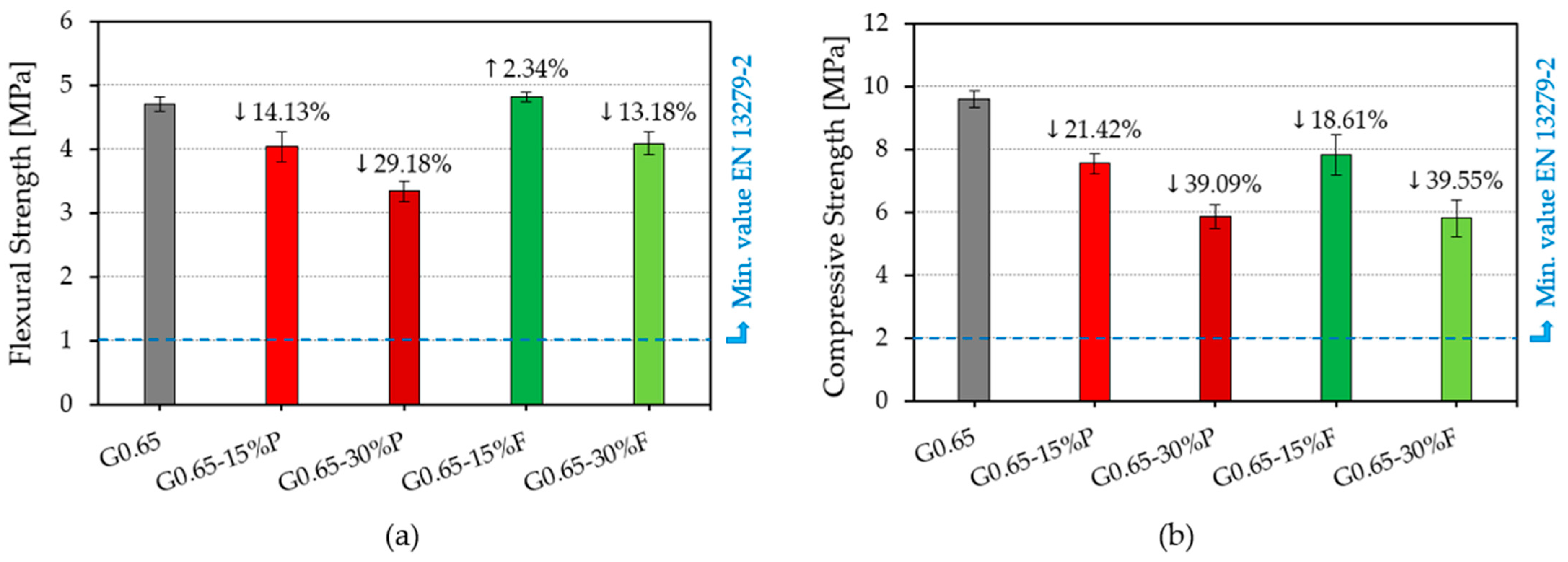

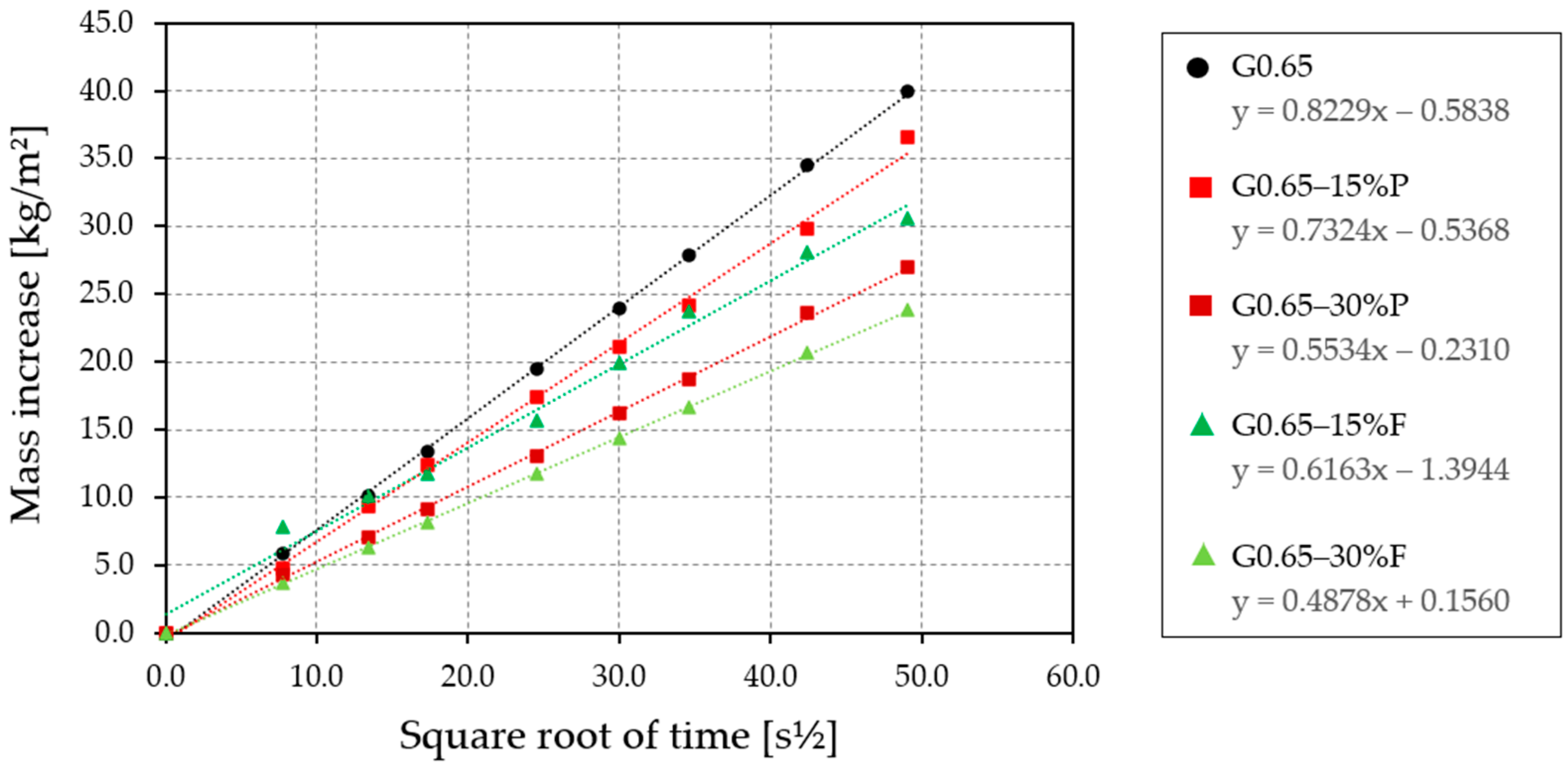
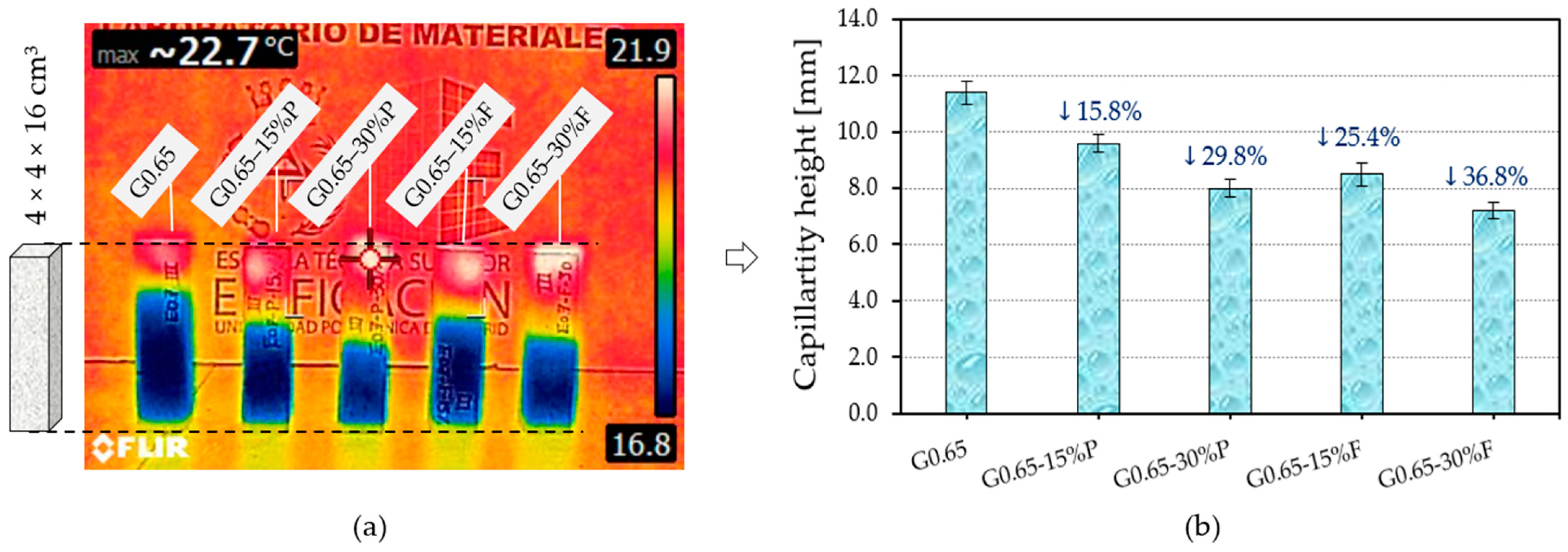
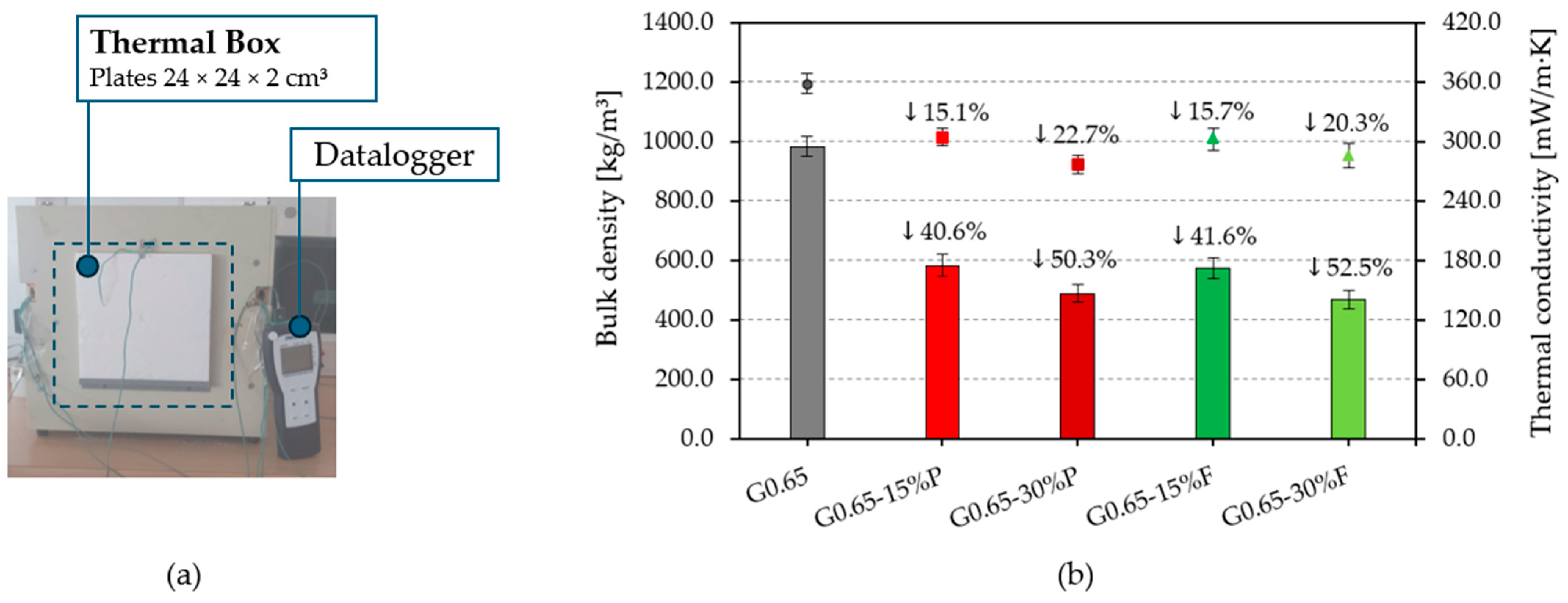

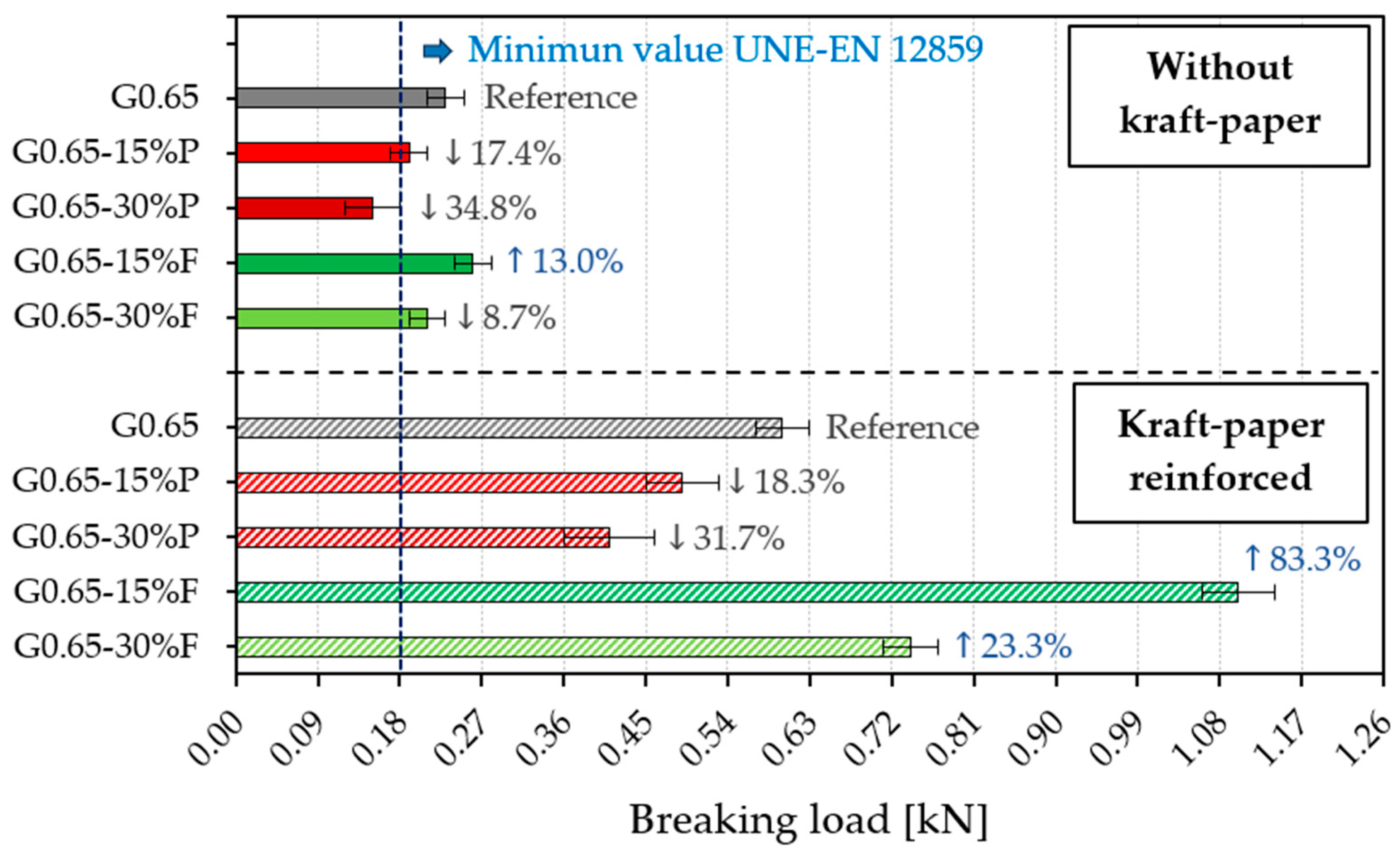


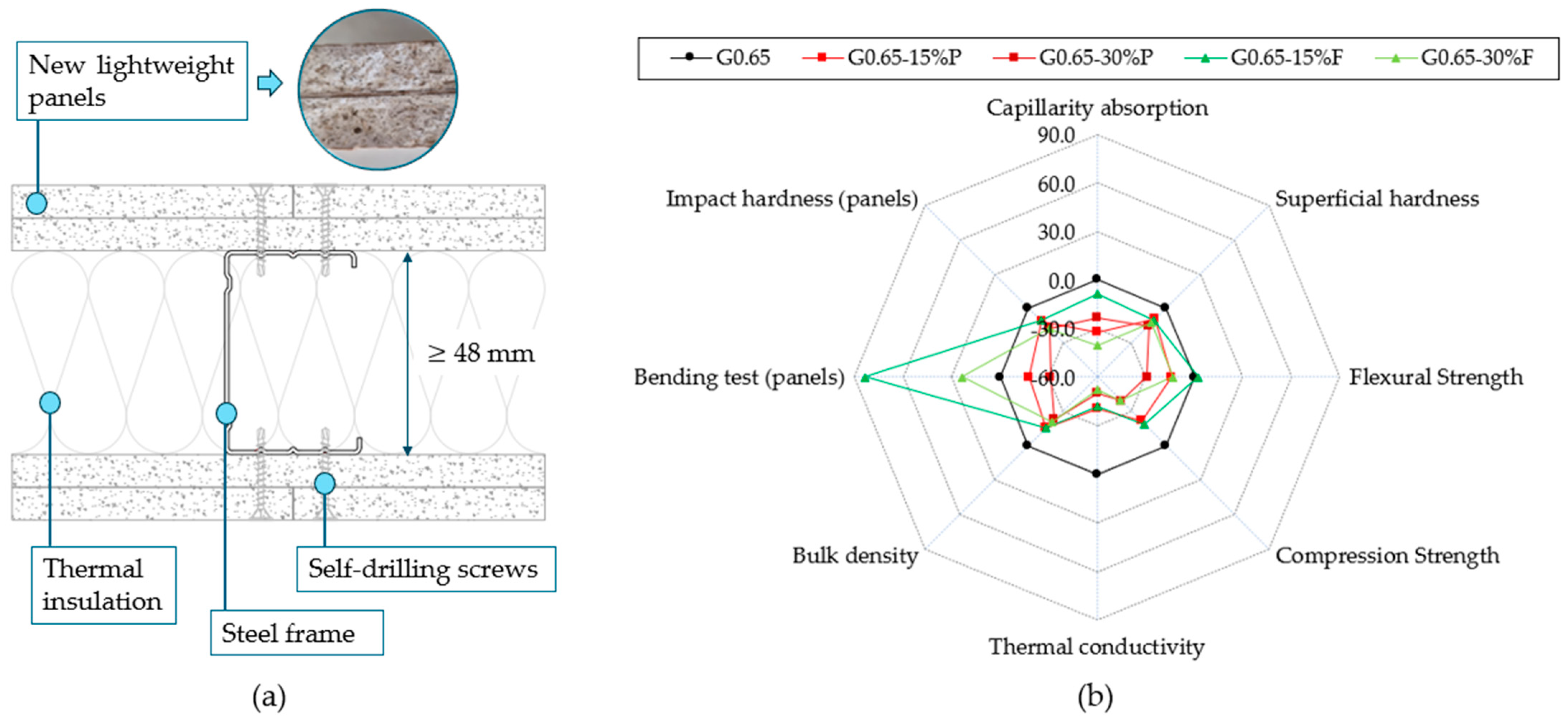
| Reference | Binder | Plant Addition | Most Relevant Results of the Study |
|---|---|---|---|
| [16] | Gypsum | Abaca fibers 1–2–3% by weight (wt.) | Three treatments were applied to the abaca additions: (a) distilled water for 24 h at 20 °C, (b) sodium hydroxide (NaOH), and (c) ethylene diamine tetraacetic acid (EDTA), without affecting the setting time of the gypsum composites. The addition of 2% wt. yielded the best results in the flexural strength test. |
| [17] | Gypsum | Wheat residues 0–2.5–5–7.5–10% wt. | The progressive substitution of gypsum material with wheat residues reduced the mechanical strengths of these composites. However, its use is feasible in the interior of buildings with low humidity, as it exhibits a good thermal and acoustic performance. |
| [18] | Plaster | Sisal fibers 0–0.52–0.78–1.04% by volume (vol.) | The best flexural strength results were obtained for fibers with a length of 120 mm and 0.78% substitution by volume, experiencing greater deformation capacity. |
| (a) [19] and (b) [20] | Plaster | Cork aggregates (a) 6–20% wt. (b) Cork/Plaster ratio 0.025–0.05–0.075–0.1–0.15–0.2% wt. | (a) Prefabricated gypsum and cork elements were designed, demonstrating excellent ductility with good buckling and bending resistance. They are suitable for use as partition walls. (b) Lightweight composites with thermal conductivity ranging from 0.46 to 0.168 W/m·K suitable for non-structural applications were obtained. |
| [21] | Plaster | Wood–Cereal Straw 0–5–10–15–20% (vol.) | The incorporation of these plant residues enables the production of lightweight gypsum composites with low thermal conductivity and low effusivity, making them competitive with traditional materials. |
| [22] | Plaster | Alfa fibers 0–1–2–3–4% wt. | The random fiber distribution in the composites led to a reduction in thermal conductivity, allowing the production of prefabricated elements with ductile fracture, albeit with a lower flexural strength. |
| [23] | Plaster | Jute fabrics 0.1–0.2% wt. | Jute fabrics embedded in the plaster matrix were used to enhance the ductility and toughness of the composites subject to bending and compression, making them suitable for the production of prefabricated elements. |
| [24] | Gypsum | Rice husk and coir fiber 10–20–30% wt. | The produced composites exhibited an excellent thermoacoustic performance, with good flexural strength and a lower environmental impact due to the reduction in the consumption of traditional gypsum. |
| [25] | Gypsum | Date palm fibers 0–5–10–15–20% wt. | A significant improvement in thermal properties was achieved by adding date palm fibers to gypsum. This allowed for a reduction in the overall energy consumption of buildings constructed with these composites, as demonstrated in the theoretical simulations that were conducted. |
| Purity Index [%] | Fire Reaction | Flexural Strength [MPa] | Compressive Strength [MPa] | pH | Water Vapor Diffusion (μ) | Granulometry [mm] |
|---|---|---|---|---|---|---|
| 80 | A1 | >1 | >2 | >6 | 6 | 0.0–0.2 |
| Time [s] | Action |
|---|---|
| 180 | Manual mixing of hemp additions with gypsum powder until a homogeneous mixture is obtained. |
| 30 | Progressive dusting of gypsum powder (with or without hemp addition) onto mixing water. |
| 60 | Rest time before the mixing begins. |
| 30 | Manual mixing by means of a constant helical movement. |
| 30 | Intermediate mixture rest time. |
| 30 | Manual mixing by means of a constant helical movement. |
| 120 | Mold filling and manual compaction (approximately 20 shakes from a one-centimeter height). |
| Series | Volume Ratios [%] | Mass Quantities [g] | ||||||
|---|---|---|---|---|---|---|---|---|
| Gypsum | Water | Powder | Fiber | Gypsum | Water | Powder | Fiber | |
| G0.65 | 60.6 | 39.4 | — | — | 1000 | 650 | — | — |
| G0.65–15%P | 51.5 | 33.5 | 15.0 | — | 850 | 553 | 30 | — |
| G0.65–30%P | 42.4 | 27.6 | 30.0 | — | 700 | 455 | 60 | — |
| G0.65–15%F | 51.5 | 33.5 | — | 15.0 | 850 | 553 | — | 25 |
| G0.65–30%F | 42.4 | 27.6 | — | 30.0 | 700 | 455 | — | 50 |
| Series | G0.65 | G0.65–15%P | G0.65–30%P | G0.65–15%F | G0.65–30%F |
|---|---|---|---|---|---|
| Surface Hardness [Shore C units] | 86 ± 1 | 78 ± 2 | 73 ± 1 | 77 ± 1 | 75 ± 1 |
| MOEus [MPa] | 5196 ± 89 | 4212 ± 102 | 3608 ± 34 | 4286 ± 28 | 3788 ± 91 |
| Reference | Binder | Addition | Flexural Strength [MPa] | Compressive Strength [MPa] |
|---|---|---|---|---|
| [54] | Plaster | 10% wt., cork granulates (<1 cm) | 2.15 | 4.88 |
| [34] | Gypsum | 94% gypsum, 6% hemp fiber (15 mm) | 7.20 | 8.30 |
| [51] | Plaster | 1% wt., rice husk | 3.54 | 7.88 |
| [55] | Gypsum | 6% wt., jute fiber | 2.46 | — |
| [24] | Gypsum | 70% gypsum, 30% coir | 5.23 | — |
| [56] | Gypsum | 3.5% wt., cellulose acetate fibers | 2.40 | 7.10 |
| [57] | Plaster | 1% wt., end-of-life tire textile fibers | 4.96 | 7.36 |
| Series | G0.65 | G0.65–15%P | G0.65–30%P | G0.65–15%F | G0.65–30%F |
|---|---|---|---|---|---|
| Total Water Absorption [%] | 42.5 ± 1.2 | 39.3 ± 0.9 | 37.2 ± 1.2 | 37.8 ± 0.8 | 36.7 ± 1.0 |
| Open Porosity [%] | 40.9 ± 0.6 | 38.1 ± 0.6 | 37.0 ± 0.7 | 37.1 ± 1.1 | 34.8 ± 0.9 |
Disclaimer/Publisher’s Note: The statements, opinions and data contained in all publications are solely those of the individual author(s) and contributor(s) and not of MDPI and/or the editor(s). MDPI and/or the editor(s) disclaim responsibility for any injury to people or property resulting from any ideas, methods, instructions or products referred to in the content. |
© 2024 by the authors. Licensee MDPI, Basel, Switzerland. This article is an open access article distributed under the terms and conditions of the Creative Commons Attribution (CC BY) license (https://creativecommons.org/licenses/by/4.0/).
Share and Cite
Ferrández, D.; Álvarez, M.; Zaragoza-Benzal, A.; Cobo-González, Á.; Santos, P. Development and Characterization of Innovative Hemp–Gypsum Composites for Application in the Building Industry. Appl. Sci. 2024, 14, 2229. https://doi.org/10.3390/app14062229
Ferrández D, Álvarez M, Zaragoza-Benzal A, Cobo-González Á, Santos P. Development and Characterization of Innovative Hemp–Gypsum Composites for Application in the Building Industry. Applied Sciences. 2024; 14(6):2229. https://doi.org/10.3390/app14062229
Chicago/Turabian StyleFerrández, Daniel, Manuel Álvarez, Alicia Zaragoza-Benzal, Álvaro Cobo-González, and Paulo Santos. 2024. "Development and Characterization of Innovative Hemp–Gypsum Composites for Application in the Building Industry" Applied Sciences 14, no. 6: 2229. https://doi.org/10.3390/app14062229
APA StyleFerrández, D., Álvarez, M., Zaragoza-Benzal, A., Cobo-González, Á., & Santos, P. (2024). Development and Characterization of Innovative Hemp–Gypsum Composites for Application in the Building Industry. Applied Sciences, 14(6), 2229. https://doi.org/10.3390/app14062229









